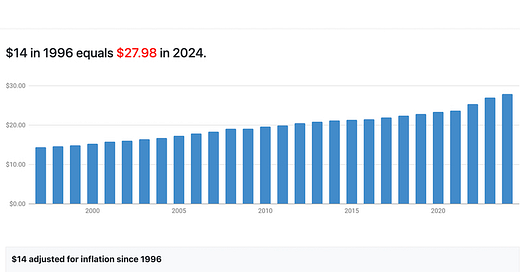Cloudy Bay, inflation fighter!?
Some days it feels as if inflation is unstoppable: Food, gas, real estate. Where will it stop? But a familiar New Zealand wine offers a wisp of hope.
I’m talking about the iconic Cloudy Bay Sauvignon Blanc, the wine that first put New Zealand on the wine map for many Americans back in the 1980s.
But wait, I can hear you saying: Cloudy Bay Marlborough Sauvignon Blanc is a good wine, but no one ever accused it of being a cheap wine. Its current average U.S. retail price is $34, according to Wine-Searcher.com’s database.
Do you enjoy Cloudy Bay and other New Zealand Sauvignon Blancs? Join the conversation on Substack Chat!
To put that into perspective, Wine-Searcher’s database shows dozens of trophy-level Sauvignon Blancs commanding three-figure prices, led by the absurd $3,809 price tag on a single bottle of Screaming Eagle Oakville California Sauvignon Blanc. That’s fine for newly minted gazillionaires who want to show off, but not for me, and I’m pretty sure not for most of you.
Cloudy Bay, though, is a wine I’m willing to invest in, at least for a reasonably special occasion.
For a while there, back around the turn of this century, it looked as if Cloudy Bay was headed up that inflationary mountain, too. I had been able to buy it for around $14 for the 1995 vintage, so $20 seemed a bit spendy just four years later for the 1999, and a $23 price tag for the 2003 continued the trend.
By 2007, Cloudy Bay’s style had altered too, perhaps in pursuit of its growing international market. “I went through a period of being smitten by New Zealand Sauvignon Blanc,” I wrote that year, “particularly after Cloudy Bay burst on the world with its bold limey, gooseberry, green chile pepper aromas and flavors and soon inspired a wealth of competitors. But Technicolor soon overwhelms, and frankly, competition has also inspired overproduction and excess yields, and the Kiwi rendition isn’t the sure bet that it used to be.”
Too expensive, positioned as a luxury item by distributor Cliquot Inc (later Louis Vuitton Moët Hennessy), and made in a style that no longer rang my chimes? Nope. There’s so much wine and so little time. My interests turned in other directions from New Zealand Sauvignon Blanc.
Recently, though, I started hearing that Cloudy Bay had returned to its old form. That got my interest, but whoa! That $34 price tag – and even my relatively affordable $30 local price –put it close to the edge for me, even as a feature for this week’s paid-tier edition.
Adjusted for inflation, what would Cloudy Bay’s prices in the late 1990s look like today? The Inflation Calculator at Saving.org offers a year-by-year guide.
But then I turned to the internet for a quick calculation: Corrected for inflation, what would Cloudy Bay’s prices in the late 1990s look like today? When I ran the numbers through the inflation calculator at Saving.org, the results were pleasantly surprising: That bottle that cost $14 in 1996 would be $27.98 today. The $20 price tag in 1999 rises to $37.43 today. The $22.99 tab on the 2001 vintage jumps to a startling $40.54 today.
Those numbers suddenly make a $30 price tag for a bottle of delicious New Zealand Sauvignon Blanc look almost like a bargain. And here’s the better news: The 2022 vintage, which is currently in the U.S. marketplace along with the reportedly similar 2023, brings me right back to memories of Cloudy Bay as it used to be: Complex, balanced, and interesting, a world-class wine from Down Under.
One caution, though, before we start stocking up on wine as a hedge against inflation: Wine pricing is unpredictable. I checked three wines I reviewed in 2000. Two of them seemed to have roughly kept pace with inflation. The third stood out as a much worse value now than a generation ago.
I paid $14.49 for the 1997 vintage of Delas Freres Crozes-Hermitage Les Launes in 2000. Adjusted for inflation, that would be $26.41 in 2024. But you can get the 2020 vintage of this wine for $25 now, with some vendors offering it in the upper teens.
Justin Vineyards & Winery Paso Robles Isosceles cost me $34.99 in 2000, which increases to $63.77 when adjusted for inflation now. Wine-Searcher shows a $75 average retail price for the 2020 vintage now, but you can find it at many vendors for $50 or less.
The $19.99 price tag on La Crau de Ma Mere Châteauneuf-du-Pape
seemed like a good deal for the 1996 vintage in 2000. Adjusted for inflation, that would be $36.43 today. But the actual average U.S. price is $61 for the 2020 vintage now. Even with some vendors offering it around $50, it still has increased at a rate that makes eggs or gasoline look reasonable.
The lesson here, if there is one, is that we shouldn’t assume that wine somehow magically resists inflation. But Cloudy Bay Sauvignon Blanc apparently has, and that’s just one more good reason to enjoy it.
Do you enjoy Cloudy Bay and other New Zealand Sauvignon Blancs? Join the conversation on Substack Chat!
I don’t accept wine samples or other gratuities from the industry, so I rely on paid-tier subscribers to help me cover the cost of wines like Cloudy Bay Sauvignon Blanc. If you’re not already on board, I’d love to have your support. Please consider subscribing to our paid-tier edition.
Support The 30 Second Wine Advisor with your paid-tier subscription. For $5 per month or $50 for a year (a 17% saving), you’ll receive additional wine notes funded by your subscriptions, gain quick direct access for wine-related questions, and gain my real appreciation for your maningful support.
Keep reading with a 7-day free trial
Subscribe to The 30 Second Wine Advisor to keep reading this post and get 7 days of free access to the full post archives.






